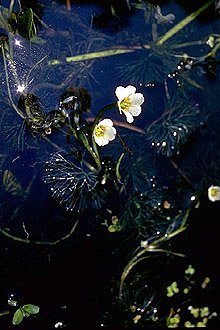- Cabomba caroliniana
Taxobox
name = Cabomba caroliniana

image_width = 240px
regnum =Plant ae
divisio =Magnoliophyta
classis =Magnoliopsida
ordo =Nymphaeales
familia =Cabombaceae
genus = "Cabomba "
species = "Cabomba caroliniana"
binomial = "Cabomba caroliniana"
binomial_authority = Gray (1837)"Cabomba caroliniana", commonly known as Green Cabomba, is an aquatic perennial herbaceous plant native to South America. It is a Weed of National Significance in Australia. [http://www.weeds.org.au/natsig.htm]
Common names
Green Cabomba, Fanwort, Carolina Fanwort, Fish grass, Washington grass
Distribution
South America (Amazon region), eastern and west coastUnited States [cite web
title = PLANTS Profile for Cabomba caroliniana
publisher = USDA Natural Resources Conservation Service
url = http://plants.usda.gov/java/profile?symbol=CACA
accessdate = 2008-01-07] Eaten as a vegetable in some areas.Ecological aspects
Grows rooted in the mud of stagnant to slow flowing water, including streams, smaller rivers, lakes, ponds, sloughs, and ditches. In some States in the
United States it is now regarded as a weed. Fanwort stems become brittle in late summer, which causes the plant to break apart, facilitating its distribution and invasion of new waterbodies. It produces seed but vegetative reproduction seems to be its main vehicle for spreading to new waters. Growth of 50 mm a day has been reported in Lake Macdonald in Queensland, Australia.Global Invasive Species Database: [http://www.issg.org/database/species/ecology.asp?fr=1&si=402&sts=] ]Large numbers of plants are sent from Florida to the rest of the U.S. for commercial use. Fanwort is also grown commercially in Asia for export to Europe and other parts of the world. Small-scale, local cultivation occurs in some area and
aquarists are probably responsible for some introductions.Description
Fanwort is a submersed, sometimes floating, but often rooted, freshwater
perennial plant with short, fragilerhizomes . The erect shoots are upturned extensions of the horizontalrhizomes . The shoots are grass green to olive green or sometimes reddish brown. Theleaves are of two types: submersed and floating. The submersedleaves are finely divided and arranged in pairs on the stem. The floatingleaves , when present, are linear and inconspicuous, with an alternate arrangement. They are less than 1/2 inch long and narrow (less than 1/4 inch). Theleaf blade attaches to the centre, where there is a slight constriction. Theflowers are white and small (less than 1/2 inch in diameter), and they float on the water surface.Cultivation
A nutriment rich water on the soft side. Additional carbon dioxide will encourage strong growth. The easiest of the Cabomba species to grow in the
aquarium but needs a strong bright light. Plant in groups. Can grow fast in good conditions. If the water circulation is too strong or with some fish (which like to nibble at it), because of its brittle stems, filters may become clogged.References
*Ørgaard, M. (1991). The genus "Cabomba" (Cabombaceae) - a taxonomic study. Nordic Journal of Botany 11: 179-203
*Gleason, H.A. and A. Cronquist. 1991. "Manual of Vascular Plants of Northeastern United States and Adjacent Canada". The New York Botanical Garden, Bronx, New York.
*Hotchkiss, N. 1972. "Common Marsh, Underwater and Floating-leaved Plants of the United States and Canada". Dover Publications, Inc., New York.
*Radford, A.E., H.E. Ahles, and C.R. Bell. 1968. "Vascular Flora of the Carolinas". The University of North Carolina Press, Chapel Hill.
*Riemer, D.N. and R.D. Ilnicki. 1968. "Overwintering of Cabomba in New Jersey". Weed Science 16:101-102.External links
* [http://192.38.244.204/go.asp?plant=015 Tropica]
* [http://plants.ifas.ufl.edu/cacapic.html Center for Aquatic and Invasive Plants]
* [http://plants.usda.gov/java/profile?symbol=CACA US Dept of Agriculture]
* [http://www.ecy.wa.gov/programs/wq/plants/weeds/cabomba.html Fanwort invasion in Washington waters]
* [http://www.aquahobby.com/garden/e_cabomba.php Age of Aquariums]
* [http://www.missouriplants.com/Whiteopp/Cabomba_caroliniana_page.html Missouri plants]
Wikimedia Foundation. 2010.
